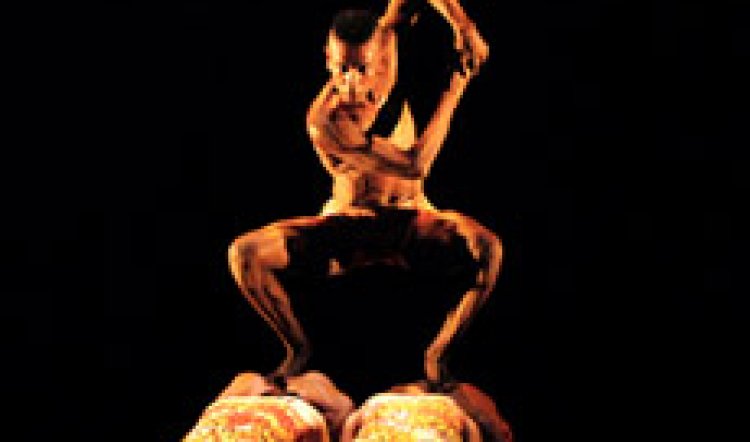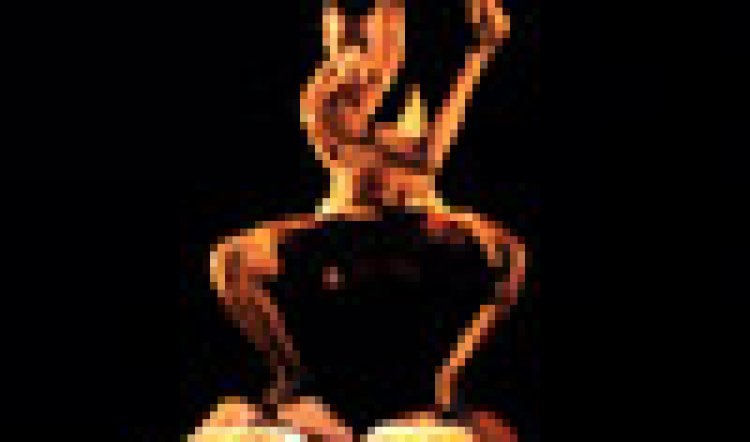
Bangarra Dance Theatre
True Stories, Drama Theatre at Sydney Opera House
Years ago, when (white) art facilitators and coordinators introduced canvas, paper, oils and acrylics to indigenous artists in remote communities, the idea was that they would produce "traditional" artworks with modern materials. Consequently the well-meaning coordinators ordered up big on burnt umber, raw siena, yellow ochre and otherproper colours. Some years down the track, artists - particularly women - began demanding different hues such as shocking pink, crimson, cerise and orange. Some coordinators were shocked and reluctant - these colours were not their idea of Aboriginal art. The artists eventually prevailed and today's indigenous artists choose their colours just like other artists: personal whim and inspiration.
A similar thing occurred later, in the 1990s, with the women of Hermannsburg. After a similar intervention via a visiting artist, they had begun making decorative pots in the traditional manner of the Navajo native Americans of New Mexico (clay rolled thin and built up in a spiral, then smoothed to a flat surface, painted and fired). Just as the painters had taken up the introduced media and quickly made it their own, so did the Hermannsburg potters. The resulting ceramics were scooped up avidly as a new form of indigenous art. The pots were quite unlike that of the revered "high-art" of Thancoupie. Accessible and attractive, the pieces were decorated with traditional colours and motifs (dots and elements of story). Then, as artists are wont to do, the women started looking about and ranging further than Arrernte country for inspiration. As well as parenti, parrots and other local critters, the pot lids began featuring giraffe, lions, zebra and so on. Horrors! This was not "Aboriginal art"!
And if the occasional wrinkled nose and frown, or muttered comment on opening night is anything to go by, what Frances Rings is doing as a choreographer right now is eliciting the same sort of reaction. And just as it did back in the 1980s and 1990s, it is a reaction that says much more about the rigidly conventional thinking of customers than it does about the artist.
Rings - former Bangarra dancer and now rapidly emerging choreographer of note - contributes the second half of the company's current double bill True Stories. And she has very definitely leapt out of and left behind the box marked "Acceptably Understandable Traditional Indigenous Artworker."
Rings' dance language has developed mightily since her early work and is now a seamless amalgam of contemporary and ancient; one might dare call it an Australian dance language. Her latest work is titled X300 - the code name given to atomic tests carried out in the 1950s at Maralinga by the Brits. Rings has fashioned a complex, episodic piece from the true stories of the people of the South Australian desert country north-west of Adelaide. Actually, unknown to them, their country was the 20th century's Terra Nullius: declared uninhabited by the Australian government and therefore ideal for the toxic experiments.
[page]In X300 the dancers begin on the floor (at a waterhole) in a tight, abstract image of intertwined feet and legs; city folk are represented in a vivid sequence of wild jitterbug, while more ensemble floorwork follows in patterns and shapes of undulating, constantly changing beauty. Slowly, the dancers segue through colours, places and emotions as everyday life gives way to images of radiation sickness, clinging viruses, bewilderment and despair. The storytelling is at once vivid, subtle and bold. The choreography utilises the strengths of contemporary dance, indigenous tradition and the sophistication and discipline of the dancers to great effect. Patrick Thaiday's solo, Black Mist is outstanding, but that's to take nothing from the rest of the troupe.

Stephen Page, Bangarra's founder-director, is a creative and managerial force whose foresight and generosity in recognizing, nurturing and promoting talent in others is something a lot more artistic directors should emulate. That he pushed and encouraged Frances Rings to take the step from performer to creator is now reaping rewards in her visibly growing confidence and imagination. The same can also be said of Elma Kris, another of Bangarra's homegrown choreographic talents.
 Elma Kris's work Emeret Lu opens the double bill. She too is exploring the possibilities of contemporary western dance, nevertheless, this work is a lyrical celebration of the distinctive people and cultural traditions of Murray Island, in the Torres Strait. In a stylized setting of a Bowerbird nest constructed of bamboo, the dancers - with guest artist Smilar Sinak - take the audience on journey through the stories and daily activities of the people of Mer: rain dancing, harvesting, wind-raising and so on. It's an evocative and fascinating piece and Smilar Sinak is a stage presence similar to the long-time Bangarra traditional adviser and guest artist from Arnhemland, Djakapurra Munyarryun. Like his predecessor, Sinak is a big man, and his stage presence, craft and astonishing lightness of being make him a magnetic figure. Also outstanding contributors are the company's set designer, Genevieve Dugard, lighting designer Glenn Hughes and costume designer, Jennifer Irwin.
Elma Kris's work Emeret Lu opens the double bill. She too is exploring the possibilities of contemporary western dance, nevertheless, this work is a lyrical celebration of the distinctive people and cultural traditions of Murray Island, in the Torres Strait. In a stylized setting of a Bowerbird nest constructed of bamboo, the dancers - with guest artist Smilar Sinak - take the audience on journey through the stories and daily activities of the people of Mer: rain dancing, harvesting, wind-raising and so on. It's an evocative and fascinating piece and Smilar Sinak is a stage presence similar to the long-time Bangarra traditional adviser and guest artist from Arnhemland, Djakapurra Munyarryun. Like his predecessor, Sinak is a big man, and his stage presence, craft and astonishing lightness of being make him a magnetic figure. Also outstanding contributors are the company's set designer, Genevieve Dugard, lighting designer Glenn Hughes and costume designer, Jennifer Irwin.
Musician-composer David Page says there are plans in hand to adapt and release his X300 music on CD if funds permit. This is good news because it should have a life of its own beyond the stage. It's a pity ABC Classics has such a dull and reductive idea of what makes a collection of music. (Floor sweepings from the archives gathered under simpering titles such as "Music to Stir Tea By" or "Airs for Summer Mornings".) If they made a bigger effort to fulfill the ABC charter, they would be banging on Page's door.
Meanwhile, True Stories is on the final lap of a national tour, but it's difficult to imagine there won't be an avid audience overseas waiting for this latest step in the Bangarra story.
(For more on Hermannsburg potters: www.hermannsburgpotters.com.au; and go to www.balgoart.org.au for examples of the kinds of paintings described above.)



